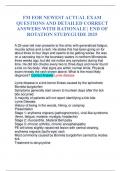Exam (elaborations)
FM EOR NEWEST ACTUAL EXAM QUESTIONS AND DETAILED CORRECT ANSWERS WITH RATIONALE | END OF ROTATION STUDYGUIDE 2025
- Course
- Institution
FM EOR NEWEST ACTUAL EXAM QUESTIONS AND DETAILED CORRECT ANSWERS WITH RATIONALE | END OF ROTATION STUDYGUIDE 2025
[Show more]



